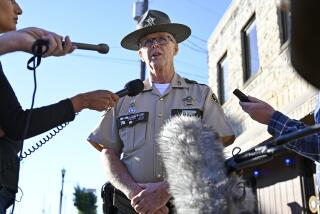Ohio Sniper Hunt Turns Fear Into Backdrop for Daily Lives
OBETZ, Ohio — The first time federal investigators stopped by James Gearheart’s house, asking about the 18 shootings along Interstate 270 in southern Franklin County last year, the disabled Army veteran and convicted burglar said he was curious.
Like other area residents, Gearheart has felt the tension build in recent months over the unsolved series of apparently random shootings that began in May. In November, one of the shootings took the life of 62-year-old Gail Knisley.
Finding the culprit, Gearheart said, is something everyone wants.
But as investigators began to ask Gearheart questions -- detailed and probing questions about guns -- he said his curiosity turned to fear.
“I was a thief, and I did my time 20 years ago. I live a good life now,” said Gearheart, 55. “I’m not a murderer. I’m not the sniper.”
Gearheart, however, is one of hundreds of people being questioned about the shootings.
“Persons of interest continue to be investigated as rapidly as possible,” Franklin County Sheriff Jim Karnes said in a statement. “Those that cannot be immediately eliminated rise to the level of suspect.”
While the investigation continues, and the weeks pass with no one charged in the crime, residents in this town of 4,000 say they are growing used to living under such tension. They say they have begun to make subtle, almost unconscious, shifts in their daily lives to account for it.
“I have friends who won’t drive I-270 anymore. I have family who use surface streets instead of the interstate,” said Jerri Decker, 65, who lives down the street from the Gearhearts. “Me? I drive it, and I cross myself. And I wonder if I know the sniper.”
Snowflakes swirl through the air like shredded tissue paper, painting the homes along Glendora Road in cold white.
Inside the Gearhearts’ tiny one-story house, their children’s academic certificates and cheerleader photos adorn the walls. In sharp contrast, jailhouse tattoos cover James’ arms.
In the 1970s, he said, he was poor and young and stupid, “hungry for money and willing to take it.” Faking deals and forging checks got him rich, but landed him in San Quentin Prison in California for more than a year.
A subsequent burglary conviction in Ohio gave him a second strike and another four years in prison.
Freed in 1985, “I got a job with the city and I cleaned up my life,” he said. “We moved to this house 13 years ago, and we tried to live quietly.”
To most people here, the shootings are still illogical, if not insane. On Oct. 10, a car tire was shot out. The next day, it was a car window. Over the next 10 weeks, shots continued to pierce car doors and school buses, and shatter school windows. The South-Western School District closed early for the holidays, and sent about 20,000 kids home on Dec. 18 and 19, after bullet marks were discovered on two of its buses.
None of the shootings seemed to fit a pattern, not the time or location. It’s the randomness of the violence that remains scary.
“We don’t talk about it much,” said Carly Johanson, 41, while shopping at a hardware store. “We don’t even think about it anymore. We just don’t go anywhere near 270.”
Such behavior speaks to a natural progress of emotionally coping with life after a tragedy, said Jack Levin, co-author of “The Will to Kill: Making Sense of Senseless Murder,” and director of the Brudnick Center on Violence and Conflict at Northeastern University in Boston.
“After a while, it becomes part of the landscape that you have to navigate on an everyday basis,” he said.
Police officers have become another common sight. They continue to scour these neighborhoods, offering a $60,000 reward for information leading to an arrest and indictment in the shootings.
Numbered among the 3,270 leads that have been submitted to a multi-agency law enforcement task force was an anonymous tip that Gearheart had guns at his home -- a violation of federal law, which prohibits convicted felons of either owning a gun, or having the power and the intent to have access to one.
Catherine Gearheart said she had bought several guns, ranging from a 9-millimeter handgun to various rifles, over the years for personal protection.
The Gearhearts said they had offered to hand over the guns.
But on Tuesday, officers from the Bureau of Alcohol, Tobacco and Firearms served the family with a search warrant, seeking guns as well as photographs, film, financial records and other personal documents. ATF officials removed a .45-caliber automatic handgun and two rifles, the Gearhearts said.
Law enforcement officials have not disclosed what caliber weapon was used in the shootings. While six of the shootings have been linked to the weapon that killed Knisley, officials have not recovered intact bullets from each crime scene and cannot connect them all with ballistics tests.
“The investigation is continuing, and there is a multitude of material we need to sift through,” said Senior Special Agent Patrick Berarducci, spokesman for the Columbus office of the ATF, which is part of the task force.
And for the Gearhearts, that process has meant not just having their home searched, but the realization that they are among those being viewed with suspicion.
“We’re living a nightmare,” Gearheart said. “I want the real sniper to be found, so all this can go away.”
More to Read
Sign up for Essential California
The most important California stories and recommendations in your inbox every morning.
You may occasionally receive promotional content from the Los Angeles Times.










